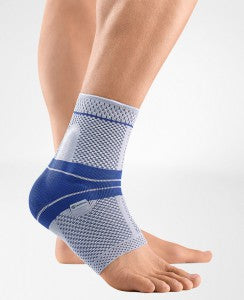
Resistance band training is fabulous for older adults. It's slow, controlled, and can improve flexibility, balance, coordination, and strength while protecting the joints.
There is even evidence that resistance training can help with arthritis and joint pain - more reason to move with these gentle yet effective exercises.
Other benefits for seniors of using resistance bands:
- They are light and are therefore easy to carry
- They can be used anywhere: in a park, at home, with no need for a gym
- Often the exercises can be done in a seated position, therefore useful for those with limited mobility
If you don't have resistance bands yet, click here to learn more.
Here are our top 5 resistance band exercises for seniors. Enjoy!
Overhead arm raises
These exercises will help you strengthen your arms and shoulders. You'll be able to reach high objects more efficiently, and you'll enjoy greater flexibility in your upper body.
- Stand with your feet hip-distance apart, and wrap your resistance band under one foot. We'll start with the right foot.
- Ensure the resistance band is securely underneath the heel of your foot so that it doesn't snap up during the exercise.
- Hold the other end of your resistance band in your right hand. Bring your arm up so that your elbow is pointing towards the ceiling. Your hand should be just behind your neck.
- Slowly straighten that arm above your head while keeping hold of the resistance band. Pause at the top and then bring the arm back down and repeat on the other side.
Variation while seated:
- Wrap one end of the resistance band around the leg of a desk or table or another stationary object.
- Using one hand or both hands together, hold the other end of the band.
- Raise your arms above your head.
- Pause at the top. Slowly bring your arms back down.
- Repeat as needed.
Watch this video to help you through the steps.
Variation while standing:
- Stand on the middle section of the resistance band with your feet hip-distance apart.
- Hold one end of your resistance band in each hand.
- Keeping your arms straight (but without locking your elbows), raise your arms until they reach shoulder height.
- Pause at the top and bring them back down.
Use this video to help you through the exercise.
Bicep curls
This exercise will help you carry groceries as well as small children.
- Standing in the same position as Variation 2 of the above exercise, keep your elbows close to your sides as you raise your hands to do bicep curls.
- Pause when at the top, then release back down.
- Repeat.
Here’s a Bicep Curl video.
Sitting knee extensions
This exercise strengthens your leg muscles as well as the tendons around your knees. You'll be able to tackle stairs with greater flexibility and strength.
- Tie one end of the resistance band round the leg of your chair.
- Tie the other around your ankle (just above the joint).
- Straighten the leg with the band, moving slowly and without locking your knee when you get to the top.
- Pause and then bring that leg back down again.
- Repeat reps as needed, then do the same thing on the other side.
Use this video to watch this exercise in action.
Seated hip
This is a great exercise to keep your hip joints flexible.
- Sit on a chair with the resistance band looped around your left thigh, and the ends tucked firmly underneath the heel of your right foot.
- While keeping your back straight and your legs bent, lift that left knee as high as possible. This is a small movement but a powerful one.
- Pause when your knee is as high as it will go, then lower it slowly back down.
- Repeat as needed, then do the same on the other side.
Watch how to do this exercise with a video.
Neck workout
This exercise is good for toning up your neck, which can get stiff. You can do this neck exercise either seated or standing.
- Wrap your band round the back of your head (a bit like a reverse headband).
- Hold both ends of the band in both hands, with your arms bent and your hands just above your head.
- Your elbows should be shoulder-height, with your forearms together.
- Very slowly, while holding tightly to the band, straighten your arms while keeping your elbows high. You'll feel the resistance in the back of your neck. Important: Make sure your chin is slightly tucked in and that your head is straight. Your gaze should be straight in front of you.
- Pause when the band is at its tightest point, then gently bend your arms again.
- Repeat.
You can see how to do this neck work out at the 8:40 mark.
To find out more
For general guidelines on resistance exercises for seniors along with more exercises, check out this page. Happy exercising!
 Barbara Fernandez is a freelance health and lifestyle writer and voiceover artist. She writes about all aspects of health and fitness, wellness, and nutrition.
Barbara Fernandez is a freelance health and lifestyle writer and voiceover artist. She writes about all aspects of health and fitness, wellness, and nutrition.



















 If you want the strength of silicone without the feeling, check out the
If you want the strength of silicone without the feeling, check out the 
